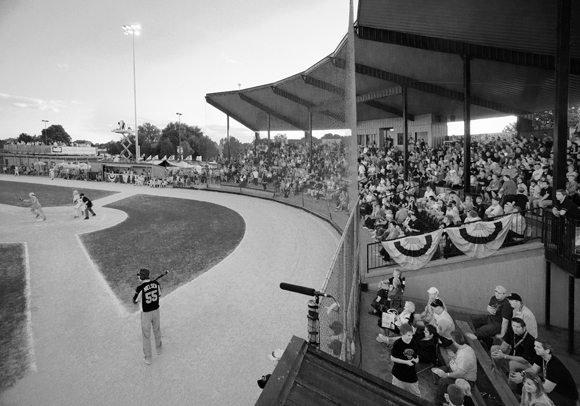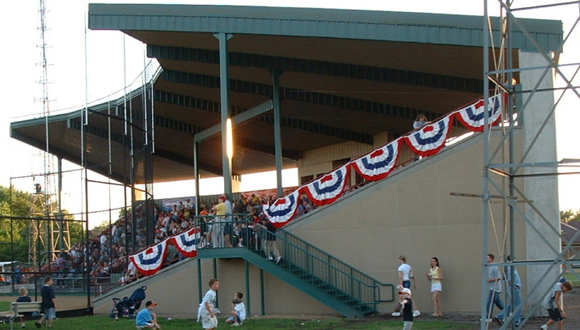Franklin Rogers Park is one of those older ballparks you can find scattered across the United States: too small to house a minor-league baseball team but large enough to attract the attention of entrepreneurs looking to bring in a summer collegiate team. Such is the case with Franklin Rogers Park, home of the Mankato MoonDogs. Even though Franklin Rogers Park has been around for fifty years, the park’s been renovated several times, so there’s very little to Franklin Rogers Park that’s really old. It’s not especially distinctive in any way, but it is a comfortable place to watch a ballgame.
FAST FACTS
Opened: 1961
Capacity: 2,000 (give or take)
Dimensions: 315L, 383LC, 381RC, 325R
Playing Surface: Grass
Website: mankatomoondogs.com
Original Name: Key City Park
Former Tenant: Mankato Mets (1967-1968)
Phone: 507/625-7047
Ticket Prices (2010): Premium, $8; Reserved Adult, $7; General Admission, $6. Dog Pound (all you can eat): Adults, $24; Children, $15.
League: Northwoods League (summer collegiate)
Parking: Free and abundant on both sides of the ballpark
Address/Directions: 601 Reed St., Mankato, MN 56001. The ballpark is north of Madison Avenue, which runs east-west from downtown Mankato to the outskirts of town. Take Long Street north of Madison Avenue. As you head north on Long, the park will be right in front of you; hang a left and then a right (or a right and then a left) to get to the parking lots.
We have no idea what the capacity of the park is anymore; at one point it was 1,100, but over the last several years the MoonDogs have added seating here and there as well as an all-you-can eat deck down left field and a party deck over the right-field concession stand. The grandstand has two sections, with multiple sections of backed seating flanked by nine rows of bleachers. (Some of the backed seating, by the way, was moved from Milwaukee’s County Stadium before it was razed.) There are also some picnic tables down the first-base line, in the midst of the concessions.
Really, there’s not much to the ballpark. The grandstand is where most of the fans sit. That’s OK. Mankato is a pretty low-key community, and a MoonDogs game is a low-key affair. The ballpark is pretty, the grandstand nice, and the atmosphere relaxed. All of these make a drive to Mankato for a MoonDogs well worth the time.
Though Key City Park opened in 1961, the city’s pro history begins in 1966, when Bismarck-Mandan dropped out of the Northern League at the end of the season. Charlie Frey, supervisor of scouting for the New York Mets, asked an old friend, Fritz Taylor, if he thought Mankato could support a pro baseball team. Frey knew the area from managing and playing for the Mankato Merchants in the Southern Minny League in the 1950s. Taylor formed a group called Mankato Area Baseball Corp. that ran the team. Taylor worked a plan to play at Key City Park, which held just 1,160 seats but could be expanded.
The Mets did their best to help promote the team. At a winter banquet intended to drum up interest in the new team, then New York manager Wes Westrum and Yogi Berra (then a Mets coach) appeared, as did Davy Jones, a teammate of Ty Cobb’s who lived in Mankato.
Despite having two very competitive teams, the Mets never caught the Key City’s imagination, drawing just 20,441 fans in its two seasons. In that brief time span, however, the Mets produced four players who eventually made it to the major leagues (Rich Hacker, Jessie Hudson, Ernie McAnally and Tom Robson). Mike Martin, who has won over 1,600 games in more than 30 seasons at head coach at Florida State, was a rookie outfielder on the 1967 team. Joe Frazier, who managed the 1968 team, eventually moved up the chain and managed the major league club in 1976 and for 45 games in 1977.
Over 40 years later, McAnally, an outfielder on that first Mankato team who later made it to the major leagues as a pitcher with Montreal, remembered his time there with a smile. “Most of us were too young and dumb to know what we were doing. Basically, you concentrated on playing baseball,” he said. “ Our president (Taylor) owned a restaurant in town (Broiler Café). We ate there a lot. That was a good thing because we were only making $550 a month.”
McAnally was a Texas native who had been a 20th-round draft pick of the Mets in 1966. Texans are known for their worldly views, but McAnally received something of a culture shock upon arriving in Mankato. “Biggest mosquitoes I have ever seen in my life,” McAnally recalled. Like many visitors to the state, he was also mystified by the weather. “I was shocked at how cold it was early in the season,” McAnally said. “I also remember we would see these clouds on the horizon and figure a storm was coming and then nothing would happen. Never saw anything like that before or since.”
Mike Martin, who later rose to fame as the longtime baseball coach at Florida State, echoed McAnally’s remembrance. “Those things used to tear holes in our sanitaries (socks) and we would start bleeding,” Martin said. “I came from Florida and thought we had some big mosquitoes there. But they were nothing compared to what I saw in Mankato.”
Key City Park, the team’s home field, was considered unfriendly to pitchers. “Great hitter’s park,” recalled Robson, who was en route to winning the Northern League’s Triple Crown when he was promoted to Durham halfway through the 1967 season. “The ball carried well there.” (It still does. There was an average of a home run a game there in 2007.)
Although the team didn’t play its first home game until June 25, it was a scramble to get Key City Park ready for pro baseball. Four days before the opener with Sioux Falls, the city was still laying sod in the outfield and installing crushed limestone for the warning track. The backstop wasn’t finished until the team went on its first road trip of the season.
Opening Day proved to be an omen of things to come. Although the Free Press speculated attendance might be as high as 2,500 for the game (although God knows where they would have put them), the actual final number was 1,328 – the largest crowd of the season, as it turned out – who saw 18-year-old Dave Lipp drive in the winning run in the bottom of the ninth for a 5-4 win. By the end of the first homestand, attendance was already down to an average of 776 per date.
At times, the city of Mankato — owners of the ballpark — wasn’t very helpful. The team paid a rental fee of $20 per game, highest figure in the league. After the youth seasons ended, the team got stuck with the bill for ballpark maintenance. Although the team tried several different promotions, the best attendance figure they ever managed was 1,862 for a 1968 game in which they gave away a $200 scholarship and a bicycle.
The parent club Mets put a lot of time and effort into making Mankato a success. Despite the short fences, the team sent some of their best prospects to Mankato. The Mets had the top ERA pitcher in the league in both seasons (Terry Parks in 1967 and Allan Clements in 1968). In 1967, they led the Northern League race until mid-August, finishing seven games behind St. Cloud. The next season, the Mets and Rox tangled again in a tight pennant race. The team set a Northern League record with 84 stolen bases for the season, including nine in one game against Duluth-Superior. However, a late August game at Huron that was rained out and couldn’t be made up proved to be important. Mankato finished the season with a 42-27 won-loss mark but lost the title by a half-game when the Rox rallied for a win at Duluth on the final day of the season.
None of it translated to success in the stands. Before the 1968 season ended, the Mets announced they were giving up sponsorship of the team. (As it developed, this was the beginning of the end of the old Northern League. The entire operation folded three years later.)
The town settled into a solid niche with its amateur baseball teams and its longstanding softball program. It was a marriage that seemed destined to last forever. When Kenosha, an original member of the college-level amateur Northwoods League, closed its gates after the 1998 season, Mankato signed up. By this time, Key City Park had been renamed Franklin Rogers Park and had roughly the same amount of seats as in 1967-68. The Mashers (later renamed the Moondogs) have not been able to duplicate the Mets’ on-field successes, but have three future major leaguers – OF Curtis Granderson, IF Jack Hannahan and 1B Paul McAnulty. Granderson has made the biggest impression so far. In 2001, he hit .328 in 44 games for a good Mashers team that missed the playoffs on the last day of the season. Three years later, he was in the major leagues. By 2006, he was a key member of the Tigers’ surprising run to the American League pennant, and he’s now a regular member of the New York Yankees lineup.
CONCESSIONS
At first glance the concessions are limited at the Frank, but you won’t go home hungry. Culver’s frozen custard and shaved ice will cool you down on a hot day; more substantial appetites will appreciate the hot dogs, brats and burgers. Kids will appreciate the great candy selection. Kettle corn remains a favorite. And then there’s the ever-popular taco in a bag.
Sadly, the beer selection is limited to Bud products. Closed circuit to Joe and Kyle: the Schell’s Brewery is right up the road. You’re leaving money on the table with such a limited beer selection.
PARKING
The ballpark is located between Reed Street and Hope Street, and there are parking lots on both sides of the ballpark. Most fans head to the smaller Reed Street parking lot and end up parking on the street. However, the Hope Street parking lot — which is much larger — is usually wide open and much more accessible, even when there’s a large crowd at the ballpark.
FOR THE KIDS
Franklin Rogers Park is a magnet for kids. That’s partially because of its location — on the edge of a residential area — and partly because parent don’t need to be afraid to let their kids wander the ballpark.
For younger kids, there’s a playground directly to the west of the ballpark. You can’t see the game action from there when you bring the kids out, but you can easily follow the action and you have a pretty good chance of claiming a foul ball.
BEFORE/AFTER THE GAME
Mankato is a college town, so there are a good number of bars in the area. Franklin Rogers Park is on the east side of town, where Madison Avenue has been a main drag for many years. Three spots are worth checking out: Tav on the Av (1120 E. Madison Av.), within spitting distance of Franklin Rogers on Madison Avenue; Buster’s (1325 E. Madison Av.), a new spot near the ballpark on Madison Avenue; and Zanz Mexican Restaurant (1041 E. Madison Av.), which features the best cheese chilitos in the universe.







